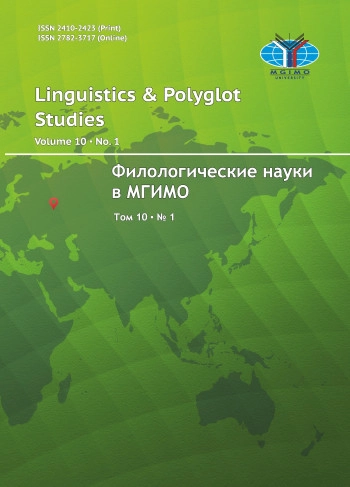Статья посвящена исследованию неологизмов, которые появились во французском языке с 2020 по 2023 гг., а также роли факторов, которые обусловили обогащение общеупотребительного французского языка в период пандемии Covid-19. Цель исследования состоит в том, чтобы установить, какие лексические единицы периода падемии Covid-19 вошли в словари Le Robert и Larousse; выяснить за счёт какой лексики с точки зрения сферы употребления произошло обогащение общеупотребительного французского языка; определить виды неологизмов, характерные для этого периода, а также установить наиболее продуктивные способы их образования; выявить зависимость между видами неологизмов и факторами, вызвавшими их появление. В процессе работы использовался междисциплинарный подход, который позволил принять во внимание связь между двумя научными дисциплинами: лингвистикой и психологией личности и включил в себя методы наблюдения, описания, интерпретации, классификации, а также лексикологического и семантического анализа. Анализ полученных результатов показал, что общеупотребительный французский язык обогатился прежде всего за счёт профессиональной лексики, в первую очередь медицинских терминов, за которыми следуют технические термины, затем военные термины; а также за счёт социальной лексики, относящейся к службам обеспечения жизни homo socialis и к его поведению в новых реалиях. Что касается видов неологизмов, появившихся в период пандемии, то среди них преобладают лексические и семантические неологизмы, в то время как количество неологизмов-заимствований крайне незначительно. Самыми продуктивными способами образования лексических неологизмов в этот период стали префиксация и контаминация. Существенное влияние на неологизацию французского языка оказали интралингвистические и экстралингвистические факторы. Последние включают в себя не только объективные, но и субъективные факторы, к которым относятся эмоциональные состояния индивида. Эмоции пандемии как ответ на экономические, культурные и психологические потрясения внесли свою лепту в процесс обновления лексического состава французского языка. Так, благодаря взаимодействию отрицательных эмоций страха, гнева и разочарования с интеллектуальными эмоциями юмора и иронии появилось большое количество лексических неологизмов, в том числе игровых дериватов, в то время как сочетание отрицательной эмоции страха и положительной эмоции интереса способствовало переходу профессионализмов в разряд общеупотребительной лексики, пополнив язык семантическими неологизмами. Эмоции пандемии, реализуя три свои функции: оценочную, побудительную и защитную, послужили своеобразным импульсом для обогащения словарного запаса французского языка. Лексикологический анализ проведён на основе материалов электронных словарей Le Robert (2023) и Larousse (2023), а также медиа-текстов французских СМИ: Le Monde, Le Figaro, La Croix, Ouest-France, Le Journal du Dimanche, Rue 89, Slate, Franceinfo.
The article is devoted to the study of neologisms that emerged in the French language from 2020 to 2023, as well as of the role of factors that caused the enrichment of the commonly used French language during the Covid-19 pandemic. The purpose of the study is to establish which lexical units of the Covid-19 pandemic period were included in the dictionaries of Le Robert and Larousse; to find out at the expense of which vocabulary, from the point of view of the sphere of use, the enrichment of the commonly used French language occurred; to identify the types of neologisms characteristic of this period, as well as to establish the most productive ways of their formation; to identify the relationship between the types of neologisms and the factors that caused their appearance. In the course of the work, an interdisciplinary approach was used, which allowed us to take into account the relationship between two scientific disciplines: linguistics and personality psychology and included methods of observation, description, interpretation, classification, as well as lexicological and semantic analysis. The analysis of the results showed that the commonly used French language has been enriched primaily by professional vocabulary, medical terms in the first place, then by technical terms, and military terms; as well as by social vocabulary related to the life support services of homo socialis and its behavior in new realities. As for the types of neologisms that appeared during the pandemic, lexical and semantic neologisms predominate among them, while the number of loan neologisms is extremely small. The most productive ways of forming lexical neologisms during this period were prefixation and contamination. Intralinguistic and extralinguistic factors had a significant impact on the neologization of the French language. The latter include not only objective, but also subjective factors, to which we refer the emotional states of an individual. The emotions of the pandemic, as a response to economic, cultural and psychological shocks, have contributed to the process of updating the lexical composition of the French language. Thus, due to the interaction of negative emotions of fear, anger and disappointment with intellectual emotions of humor and irony, a large number of lexical neologisms, including game derivatives, appeared, while the combination of negative emotions of fear and positive emotions of interest contributed to the transition of professionalism into the category of commonly used vocabulary, replenishing the language with semantic neologisms. The emotions of the pandemic, realizing their three functions: evaluative, motivational and protective, served as a kind of impulse to enrich the vocabulary of the French language. The lexicological analysis was based on the materials from the Le Robert and Larousse electronic dictionaries and from the websites of such media outlets as Le Monde, Le Figaro, La Croix, Ouest-France, Le Journal du Dimanche, Rue 89, Slate, Franceinfo.

















